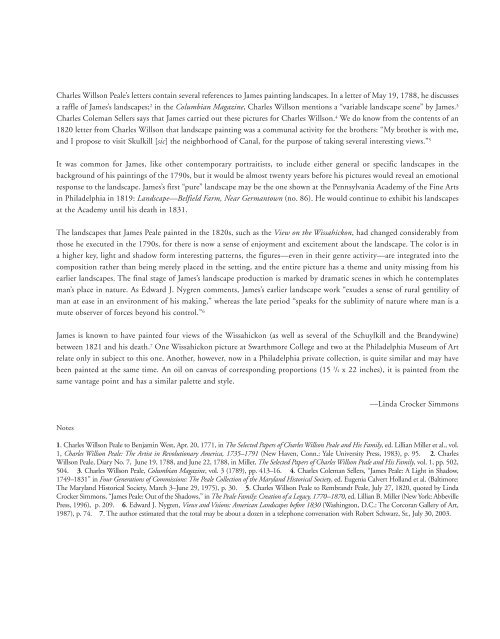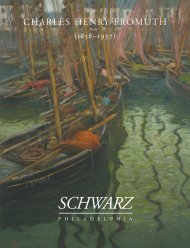pdf - Schwarz Gallery
pdf - Schwarz Gallery
pdf - Schwarz Gallery
Create successful ePaper yourself
Turn your PDF publications into a flip-book with our unique Google optimized e-Paper software.
Charles Willson Peale’s letters contain several references to James painting landscapes. In a letter of May 19, 1788, he discusses<br />
a raffle of James’s landscapes; 2 in the Columbian Magazine, Charles Willson mentions a “variable landscape scene” by James. 3<br />
Charles Coleman Sellers says that James carried out these pictures for Charles Willson. 4 We do know from the contents of an<br />
1820 letter from Charles Willson that landscape painting was a communal activity for the brothers: “My brother is with me,<br />
and I propose to visit Skulkill [sic] the neighborhood of Canal, for the purpose of taking several interesting views.” 5<br />
It was common for James, like other contemporary portraitists, to include either general or specific landscapes in the<br />
background of his paintings of the 1790s, but it would be almost twenty years before his pictures would reveal an emotional<br />
response to the landscape. James’s first “pure” landscape may be the one shown at the Pennsylvania Academy of the Fine Arts<br />
in Philadelphia in 1819: Landscape—Belfield Farm, Near Germantown (no. 86). He would continue to exhibit his landscapes<br />
at the Academy until his death in 1831.<br />
The landscapes that James Peale painted in the 1820s, such as the View on the Wissahickon, had changed considerably from<br />
those he executed in the 1790s, for there is now a sense of enjoyment and excitement about the landscape. The color is in<br />
a higher key, light and shadow form interesting patterns, the figures—even in their genre activity—are integrated into the<br />
composition rather than being merely placed in the setting, and the entire picture has a theme and unity missing from his<br />
earlier landscapes. The final stage of James’s landscape production is marked by dramatic scenes in which he contemplates<br />
man’s place in nature. As Edward J. Nygren comments, James’s earlier landscape work “exudes a sense of rural gentility of<br />
man at ease in an environment of his making,” whereas the late period “speaks for the sublimity of nature where man is a<br />
mute observer of forces beyond his control.” 6<br />
James is known to have painted four views of the Wissahickon (as well as several of the Schuylkill and the Brandywine)<br />
between 1821 and his death. 7 One Wissahickon picture at Swarthmore College and two at the Philadelphia Museum of Art<br />
relate only in subject to this one. Another, however, now in a Philadelphia private collection, is quite similar and may have<br />
been painted at the same time. An oil on canvas of corresponding proportions (15 3 /4 x 22 inches), it is painted from the<br />
same vantage point and has a similar palette and style.<br />
—Linda Crocker Simmons<br />
Notes<br />
1. Charles Willson Peale to Benjamin West, Apr. 20, 1771, in The Selected Papers of Charles Willson Peale and His Family, ed. Lillian Miller et al., vol.<br />
1, Charles Willson Peale: The Artist in Revolutionary America, 1735–1791 (New Haven, Conn.: Yale University Press, 1983), p. 95. 2. Charles<br />
Willson Peale, Diary No. 7, June 19, 1788, and June 22, 1788, in Miller, The Selected Papers of Charles Willson Peale and His Family, vol. 1, pp. 502,<br />
504. 3. Charles Willson Peale, Columbian Magazine, vol. 3 (1789), pp. 413–16. 4. Charles Coleman Sellers, “James Peale: A Light in Shadow,<br />
1749–1831” in Four Generations of Commissions: The Peale Collection of the Maryland Historical Society, ed. Eugenia Calvert Holland et al. (Baltimore:<br />
The Maryland Historical Society, March 3–June 29, 1975), p. 30. 5. Charles Willson Peale to Rembrandt Peale, July 27, 1820, quoted by Linda<br />
Crocker Simmons, “James Peale: Out of the Shadows,” in The Peale Family: Creation of a Legacy, 1770–1870, ed. Lillian B. Miller (New York: Abbeville<br />
Press, 1996), p. 209. 6. Edward J. Nygren, Views and Visions: American Landscapes before 1830 (Washington, D.C.: The Corcoran <strong>Gallery</strong> of Art,<br />
1987), p. 74. 7. The author estimated that the total may be about a dozen in a telephone conversation with Robert <strong>Schwarz</strong>, Sr., July 30, 2003.



